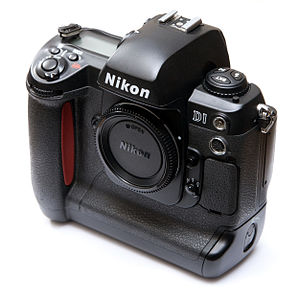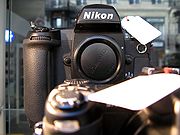- Nikon D1
-
Nikon D1 
Type Digital single-lens reflex camera Sensor CCD, 23.7 × 15.6 mm DX format, 1.5× FOV crop Maximum resolution 2,000 × 1,312 (2.7 megapixel) Lens Interchangeable, Nikon F-mount Flash 3D Multi-Sensor Balanced Fill-Flash, 5-segment TTL Multi Sensor Shutter Charge-coupled electronic and mechanical shutter Shutter speed range 30 to 1/16,000 s and Bulb, 1/500 s X-sync Exposure metering 3D Color Matrix Metering Through-the-lens (TTL) Full-Aperture exposure metering with 1,005-pixel CCD Exposure modes Programmed Auto [P] with flexible program; Shutter-Priority Auto [S]; Aperture Priority Auto [A]; Manual [M] Metering modes 256-segment Matrix Metering, Center-weighted (75% weighted 8 mm circle), and Spot (2%) Focus areas 5 areas with Multi-CAM 1300 Autofocus system Focus modes Single-servo AF (S), continuous-servo AF (C), manual (M) Continuous shooting 4.5 frame/s, up to 21 frames Viewfinder Optical ASA/ISO range 200–1600 in 1 EV steps Custom WB Auto, Six presets, Manual preset, Fine tunable Rear LCD monitor 2 in (51 mm), 120,000-dot TFT LCD Storage CompactFlash (Type I or Type II, 2GB maximum) Battery Nikon EN-4 Ni-MH battery pack (7.2V DC) Weight Approx. 1.1 kg (without battery or lens) Made in Japan The Nikon D1 is a digital single-lens reflex camera introduced on June 15, 1999.[1] It featured a 2.7 megapixel image sensor, 4.5 frames per second continuous shooting, and accepted the full range of Nikon F-mount lenses. The camera body strongly resembled the F5 and had the same general layout of controls, allowing users of Nikon film SLR cameras to quickly become proficient in using the camera. Autofocus speed on the D1 series bodies is extremely fast, even with "screw-driven" AF lenses.
Although Nikon and other manufacturers had produced digital SLR cameras for several years prior, the D1 was the first professional digital SLR that displaced Kodak's then-undisputed reign over the professional market.[2]
Unusual for a DSLR, the D1 uses the NTSC color space instead of the conventional sRGB or Adobe RGB color spaces. The resulting color on the D1 can be a bit unorthodox, but methods of correcting and/or compensating for the color problem are readily available.[3][4][5]
Contents
D1H and D1X
The D1 was replaced by the D1H and D1X on February 5, 2001.[6] The D1X offered higher resolution with a 3,008 × 1,960 - 5.3 effective megapixels sensor, and continuous shooting of 3 frames per second for up to 21 consecutive shots. The D1H was oriented towards fast action photography, keeping the same 2.7 megapixels image sensor as the D1, but pushing the frame rate to 5 frame/s for up to 40 consecutive shots. Both the D1H and D1X use the sRGB/AdobeRGB color spaces, which is an improvement over the original D1.
Development and its significance plus its Sensor Design
Development began on the D1 in 1996, when digital imaging was in its infancy in the consumer market. At that time the major market leader for DSLR cameras was Kodak, who produced their own image sensors and assembled digital cameras under the brand Kodak DCS. The DCS cameras were based upon 35 mm SLR cameras, replacing the film back with one incorporating a CCD sensor. This in turn was connected to a power supply and image processing and storage unit that was either carried separately or attached to the base of the camera body. While these cameras offered the convenience of digital imaging to normal photographers, their appeal was limited by huge price-tags and issues with sensor size, resolution, and performance in comparison to film.
Nikon therefore stood to gain a significant market advantage if they could manage to offer a digital camera that had been designed and built as one from the beginning. The goal was ambitious - Nikon sought to produce professional-grade cameras using large high-resolution sensors for but a few thousand dollars at a time when the Kodak DCS 460, based on a Nikon F90X and provided with a 6 megapixel 27.6 × 18.4 mm CCD sensor, was retailing for over US$30,000. Price though was but one of the hurdles encountered - engineers had to consider how to design and mass-produce a high-resolution and high-sensitivity sensor that could be powered by batteries and sustain a continuous frame-rate suitable for journalistic use.
Initially no sensor manufacturer was prepared to produce the sensor for Nikon, believing that the predicted sales volumes were completely unrealistic. Eventually though a foundry was located and prototype designs entered production. Several years of refinement followed - working to reduce power use and improve read speeds - until a design was perfected.
The final design that was used in the D1 was for a 23.7 × 15.6 mm CCD producing images with a final resolution of 2000 × 1312 pixels (approximately 2.7 megapixels), and this was the figure used for marketing the camera. The sensor was praised for its high base sensitivity of ISO 200, its excellent signal-to-noise ratio especially at base sensitivity, and its capacity for continuous shooting at five frames per second.
As said by Bjørn Rørslett, the camera spelt "The End of The Beginning (of the digital era) - The Beginning of The End (of the film era)". It is one of the major milestone in the development of the digital camera. Even at that time, it was not without notice how these affect the fate of Kodak which dominate both film and digital camera/sensor market at that time.
In a later "behind the scenes" interview published on the Nikon website [1] it was revealed by the General Manager of Nikon's Imaging Development Management Department that the sensor developed for and used in the D1, and subsequently the D1H, actually utilised 10.8 million photosites rather than the 2.7 million that had previously been suggested. This allowed multiple photosites to be grouped together into units that formed the final pixels in the image, contributing to the sensor's high sensitivity and excellent SNR.
References
- ^ "The Nikon D1" (Press release). Nikon Corporation. 1999-06-15. http://www.nikon-image.com/eng/news_release/1999/D1.html. Retrieved 2006-08-30.
- ^ Askey, Phil (2000-11-27). "Nikon D1 Review: 1. Intro". Digital Photography Review. http://www.dpreview.com/reviews/nikond1/. Retrieved 2009-10-25.
- ^ Hogan, Thom. "The Nikon D1, D1h, and D1x Review". http://www.bythom.com/d1series.htm. Retrieved 2009-10-25.
- ^ Kwee, Ivo. "Nikon D1 digital workflow". http://www.fotoclublugano.com/~ivo/photography/NikonD1/nikond1-workflow.htm. Retrieved 2009-10-25.
- ^ Askey, Phil (2000-11-27). "Nikon D1 Review: 16. Image Quality". Digital Photography Review. http://www.dpreview.com/reviews/nikond1/page16.asp. Retrieved 2009-10-25.
- ^ "Digital SLR Cameras D1X and D1H" (Press release). Nikon corporation. 2001-02-05. http://www.nikon-image.com/eng/news_release/2001/d1xh.htm.
External links
Official sites
- Nikon D1 Product Page – Nikon Global Website
- Nikon D1H Product Page – Nikon Global Website
- Nikon D1X Product Page – Nikon Global Website
Reviews
- ByThom.com review of the D1, D1h and D1x
- "The End of The Beginning - The Beginning of The End" A review of D1 by Bjørn Rørslett
- "Into the Night with Nikon D1X" by Bjørn Rørslett
- dpreview.com review of the D1
- dpreview.com review of the D1h
- dpreview.com review of the D1x
- photo.net review of the D1h
- Lonestar.net review of the D1, D1h and D1x
- imaging-resource.com review of the D1h
Wikimedia commons
 Media related to Nikon D1 at Wikimedia Commons
Media related to Nikon D1 at Wikimedia Commons Media related to Nikon D1H at Wikimedia Commons
Media related to Nikon D1H at Wikimedia Commons Media related to Nikon D1X at Wikimedia Commons
Media related to Nikon D1X at Wikimedia Commons
Nikon Digital SLR timeline (comparison)
Full-frame (FX format) camera. — Without an AF motor (needs lenses with integrated motor for autofocus). — HD video capable (Video AF)1999 2000 2001 2002 2003 2004 2005 2006 2007 2008 2009 2010 2011 2 3 4 1 2 3 4 1 2 3 4 1 2 3 4 1 2 3 4 1 2 3 4 1 2 3 4 1 2 3 4 1 2 3 4 1 2 3 4 1 2 3 4 1 2 3 4 1 2 3 4 Professional Flagship D1 D1X D2X D2Xs D3X D1H D2H D2Hs D3 D3S Compact D700 D100 D200 D300 D300S Consumer Advanced D7000 D70 D70s D80 D90 Mid-range D50 D40X D60 D5000 D5100 Entry-level D40 D3000 D3100 Early models Nikon Still Video Camera (Prototype, 1986) · Nikon QV-1000C (1988) · Nikon NASA F4 (1991)
Nikon E2/E2S (1995) · Nikon E2N/E2NS (1996) · Nikon E3/E3S (1998)Categories:- Nikon DSLR cameras
Wikimedia Foundation. 2010.

